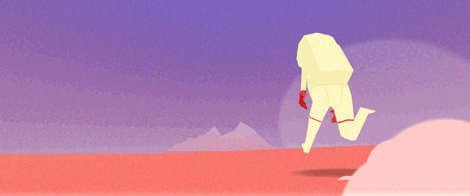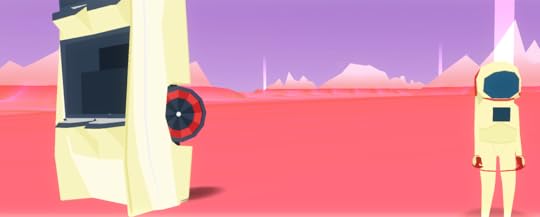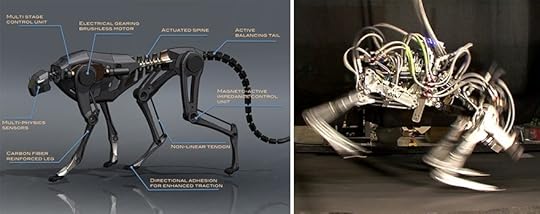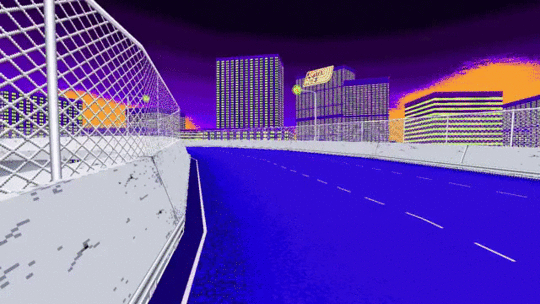Kill Screen Magazine's Blog, page 302
January 13, 2015
Drive across Mars, discover the unreal in Naut
Naut is about not knowing where you are, not knowing what is real. How did you get there? What are you doing? Not just that: it wants you to experience these unanswered questions washing over you with a warm complacency. It's a sci-fi opera with psyche-fi undertones.
But first, a story: I first got drunk when I was 15 years old. Three cans of hastily drunk Somerset cider in and my head isn't right. I go to the bathroom. There's a mirror in there, which I stare into for longer than I should, watching my pupils swim like goldfish in a bowl. I'm fascinated with all these new distortions.
thoroughly anachronistic, verging on surrealism.
Suddenly, I'm so lost in the moment that I forget where I am. I feel like I have to reverse engineer my entire life from birth to present just to work out how I got there, in my friend's bathroom, drinking the alcohol my parents and the law forbid me. Halfway through I say "fuck it" out loud, shrug my shoulders, and decide instead to roll with the confusion, laidback as a hammock. That's where Naut wants to take you.

It starts. You're on Mars. On a porch—the porch of a typical American-style, rootin'-tootin' white picket fence home, with a bay window at the front and a sports car wallowing in the shade of the garage. Around this house are miles of wild pink Martian soil, untouched. Alien flora and lumps of rock puncture the ground in unkempt patterns. And you're standing there, on this porch, in full astronaut gear.
None of this adds up. Still, that's the image that Naut opens up with. In fact, it's the background of the main menu. Why is this house here, on Mars? Why is this person wearing a spacesuit—do they need to if there are plants and buildings on the planet's surface implying a degree of terraforming has taken place? What year is it? If you're asking these questions then you've become that teen in front of the mirror, tin of strong brew cider in their hand, trying to piece together their life so that it makes sense again.
Yes, it wants you to drive. Just drive
This image of an astronaut on the porch of a domestic home on Mars is thoroughly anachronistic, verging on surrealism. But you don't dwell upon the strangeness of it all as the purple pastels all around it submit the game to the zany logic of a Chuck Jones cartoon. The Road Runner and Wile E. Coyote could run along the horizon kicking up soft clouds of dust and it wouldn't be out of place here. Anything could happen, it's a cartoon—it evades explanation.
Naut has no intention of answering any of your bemused questions. And so it doesn't. Instead, it invites you, through its ultra-widescreen format, to see the breadth of its panoramic landscapes, and to then match this with the convertible in the garage. Yes, it wants you to drive. Just drive; drive wherever whim takes you, go find something.

As you drift hazily across the apricot tundra, you'll find other wooden houses that seem to have been stolen from Pleasantville. On the porches of these houses are wavy apparitions, ghosts of people, and they'll tell you tales of legendary desert foxes and those who have gone missing in the Martian desert. The immateriality of these isolated folk suggests that they are mirages. That would probably make sense.
It's not until the forked lightning starts to frazzle the ground in operatic fashion that you learn to stop searching, and start looking. Naut is a game that wants to be looked at. It wants you to make your own compositions with the in-game camera; frame the screen with mountain ranges, park your car at the center, and hope that the lightning carves the image into thirds. Create the one perfect cinematographic shot of a lonely space cowboy in a crappy B-Western without a plot. Mock up a still from the barmy astronaut musical The American Astronaut. It doesn't have to make sense it only has to be picturesque.
enjoy the ride as the car becomes a surrogate rocket.
But this is not the ultimate in carefree to be found in Naut. For that you'll need to drive your car over rocks until it flips upside-down. There's a bug in the game you can exploit here. It's one I expect its creators know about it but have kept it in to allow for moments such as the one you're about to experience. You're not supposed to be able to beep the car horn (or "klaxon" as it's called in the game) more than twice without the car's wheels returning to the ground. This is due to the beep simultaneously bumping the car into the air, as if a pneumatic hop, and so it would be able to fly. But, once the car is upside-down, you eschew this restriction, beeping as many times as you like without pause, and as you do the car will continue to rise into the air.

So, when the car is upside-down, beep its horn, and keep on beeping it until it flies, as if the car was trying to return to a sky road it has fallen from. I imagine that the astronaut is grateful that their car is suddenly floating up into the sky, towards the edges of the habitable atmosphere, away from the planet they've been trapped on. I reckon their only compulsion would be to enjoy the ride as the car becomes a surrogate rocket.
Was it mania, or perhaps the illusions of prolonged loneliness that they experienced down there? What was real and what was hallucination? It doesn't matter now. Sure, it expresses the dichotomy of hallucinations and reality, but Naut only wants to engage your imaginative mind, not test your academic knowledge—it's Tarkovsky's Solyaris if it were remade for kids.
Notice that the camera doesn't let you look back down to the planet's surface as the astronaut ascends. There is only upwards now, destination. The only possible response is to submit to the drift. Fuck it.
We talk to Tale of Tales about sunsets, revolutions, and reflections
"I'm someone that believes people should think of revolution as a good thing."
Red alert: there are now robotic cheetahs
After seeing the "design features" that enable the cheetah to run so fast, I wanted to circle back to Boston Dynamics' robo-cheetah, which we looked at a few years ago. Their creation isn't faster than a Ferrari, but with a top speed of 28 miles per hour, it's faster than Usain Bolt.
The concept rendering is a good deal more optimistic-looking than the actually built version, which is headless, tailless and needs to be connected to an external power supply:

However, more recently another Boston-based team has been working on a cheetah-bot of their own, and this one runs under its own power. MIT has harnessed the talent from several of their departments to create their robotic cheetah, which uses a high-torque-density electric motor designed by one of their Electrical Engineering professors and motor controllers designed by another engineer in their Research Laboratory of Electronics.
Those aren't the only design differences in MIT's approach. Whereas Boston Dynamics' cheetah seemed a bit more lithe, MIT's version doesn't appear to mimic a real cheetah's bone structure. Instead mechanical engineering prof Sangbae Kim, who appears to be skippering the project, is attempting to model various cheetah-like gaits by developing algorithms.
Kim and his colleagues developed an algorithm that determines the amount of force a leg should exert in the short period of each cycle that it spends on the ground. That force, they reasoned, should be enough for the robot to push up against the downward force of gravity, in order to maintain forward momentum.
"Once I know how long my leg is on the ground and how long my body is in the air, I know how much force I need to apply to compensate for the gravitational force," Kim says. "Now we're able to control bounding at many speeds. And to jump, we can, say, triple the force, and it jumps over obstacles."
They did indeed get it to jump over things and keep running. Check it out:
What's strange is that neither Boston Dynamics nor MIT has mentioned the post-running functionality of the cheetah-bots. For example, once they catch their prey (presumably political dissidents or business competitors) how do they bring them down and dispose of them?
We'll have to wait for that answer. The first step is ensuring that no human being can outrun these things, not even Usain Bolt. While Boston Dynamics has solved the speed problem, MIT's 'bot can currently only do 10 m.p.h. So for now I'm not worried; I could outrun that thing with a beer in my hand.
This post was originally written by hipstomp / Rain Noe for Core77.
Peter Molyneux, David Cage, and Europe’s largest public school of videogames
Notes from an inauguration.
Lisa makes a monster out of you
Fulfilling the primal need for violence and glistening bodies.
January 12, 2015
A conversation with John Clowder, whose collage-like games have to be seen to be believed
Find out Where They Cremate the Roadkill.
3DHead is the gloriously inevitable clusterf*ck of our dreams
Terrible virtual reality continues its march into the future.
If the items in your suitcase could talk, what stories would they tell?
Terry Cavanagh's latest freeware game explores the narrative of move out day.
Psychopath needed for design of iconic movie maze
Inception fans need not apply.
January 9, 2015
Drift Stage is the neon-soaked anime arcade racer the universe needed
Growing up with diecast cars and car carpet city, there were two main camps: Hot Wheels and Matchbox. Matchbox represented something to appreciate from afar—nice details but not built to throw in a racing track. The raging colours and tough builds of Hot Wheels, on the other hand, screamed, “I want to go sideways!”
The synthed-out neon cityscapes and sports cars of Drift Stage’s Sunset City are much more 60’s “Redline” Hot Wheels, with heavy metallic greens and reds giving off edgy vibes, vibes of going fast.

I’ve been getting familiar with the sharp turns of this metropolis, having spent the last few hours sliding, often into walls, through an urban circuit in a bright orange car called the Bulldog.
Artist Charles Blanchard started the ground roots for the project after creating cars and art inspired by Commodore 64 racing game Lotus Esprit Turbo Challenge. He eventually tried making it into a game called Turbo Run.
“Eventually I just released all the content from Turbo Run for free, and that’s when Chase [Pettit] ended up picking it up,” Blanchard said. After a brief Twitter chat midway through 2014, they decided to work together.
“It pretty much came together out of nowhere,” Pettit, the game’s programmer, said. “I kind of on a whim, just on a weekend, thought, ‘I really miss arcade racing games.’”
An 80’s piston-lust homage
Much like the Ferrari Testarossa of Out Run or the titular vehicle of Lotus Esprit Turbo Challenge, the design of the Bulldog hoists that mantle of an iconic 80’s two-door coupé. Drift's team, going by the name Super Systems Softworks, sets the stage for an 80’s piston-lust homage with poise.
While the 80’s retro aesthetic has seen a bit of a resurgence, the state of the arcade racing genre has decidedly not, as much more realistic racing games have taken the spotlight in recent years. Yet, much like Vektor: The Courier’s pitch-perfect evocation of the dystopian vibes of Akira, Drift Stage brings the arcade racer back to its pre-millennial beginnings with a modern polish.

Music lead Hugh Myrone came to the project in a manner as happenstance as Blanchard and Pettit did—by stumbling onto GIFs of the game’s art on Tumblr. Following the reblogs lead him to Blanchard’s original post, and he inquired about making the music.
“I tweeted at both you guys, and you guys were like, ‘Yeah, I guess this guy could make the music,’” Myrone said.
Chasing my time ghosts to Myrone’s bleating 80’s synthesizer tunes, full of swooping guitar riffs over thumping beats, is a strangely modern throwback. His work evokes old Eurobeat and hints of jazz fusion band T-Square, but, like the game’s visual aesthetic, it feels tastefully updated.
It feels tastefully updated.
Super Systems’ more difficult target ghosts always seemed a step ahead further than me, cutting effortless lines while I narrowly avoided hitting the walls with my rear end. My attempts to keep up with the “expert” ghost were often in vain.
I imagined the panels of Initial D's Takumi Fujiwara sliding down Mount Akina in his Toyota AE86 Sprinter Trueno, struggling to make a pass until he hits a bump and sends his car sideways.
Drift Stage has just been launched on Kickstarter. Otherwise, you can check it out via the available technical alpha or on Steam.
Kill Screen Magazine's Blog
- Kill Screen Magazine's profile
- 4 followers



